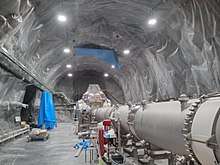KAGRA
The Kamioka Gravitational Wave Detector (KAGRA), formerly the Large Scale Cryogenic Gravitational Wave Telescope (LCGT), is a project of the gravitational wave studies group at the Institute for Cosmic Ray Research (ICRR) of the University of Tokyo.[1] It is the world's first gravitational wave observatory in Asia, the first built underground, and the first whose detector uses cryogenic mirrors. The design calls for an operational sensitivity equal to, or greater, than LIGO.[1]
 | |
| Alternative names | KAGRA |
|---|---|
| Part of | Kamioka Observatory |
| Location(s) | Gifu Prefecture, Japan |
| Coordinates | 36°24′43″N 137°18′21″E |
| Altitude | 414 m (1,358 ft) |
| Telescope style | gravitational-wave observatory project |
| Length | 3,000 m (9,842 ft 6 in) |
| Website | gwcenter |
 Location of KAGRA | |
Overview
The ICRR was established in 1976 for cosmic ray studies. The LCGT project was approved on 22 June 2010. In January 2012, it was given its new name, KAGRA, deriving the "KA" from its location at the Kamioka mine and "GRA" from gravity and gravitational radiation.[2] The project is led by Nobelist Takaaki Kajita who had a major role in getting the project funded and constructed.[3]
Two prototype detectors have been constructed to develop technologies needed for KAGRA. The first, TAMA 300, was located in Mitaka, Tokyo and operated 1998-2008, demonstrating the feasibility of KAGRA. The second, CLIO, is operating since 2006 underground near the KAGRA site, and is being used to develop cryogenic technologies for KAGRA.
KAGRA has two arms, 3 km (1.9 mi) long, which form a laser interferometric gravitational wave detector. It is built in the Kamioka Observatory near the neutrino physics experiments. The excavation phase of tunnels was started in May 2012 and was completed on 31 March 2014.
KAGRA will detect gravitational waves from binary neutron star mergers at up to 240 Mpc away with a signal to noise ratio of 10. The expected number of detectable events in a year is two or three. To achieve the required sensitivity, the existing state of the art techniques as used by LIGO and VIRGO (low-frequency vibration-isolation system, high-power laser system, Fabry-Pérot cavities, resonant side band extraction method, and so on) will be extended with an underground location, cryogenic mirrors, and a suspension point interferometer.
KAGRA has suffered numerous delays. Early planning had hoped to begin construction in 2005 and observation in 2009[4] but is now likely to enter operation in April 2020.[5] Excess water in the tunnels caused significant delays in 2014 and 2015.[6][7]
Initial operation ("iKAGRA") with room-temperature test masses was hoped to begin in December 2015.[6][8][9] The first operation of the interferometer happened in March 2016. As of early 2019, the project hoped to complete the KAGRA detector by the end of 2019 to join a gravitational wave observation campaign of LIGO and Virgo.[10] The construction of KAGRA was completed 4 October 2019, with the construction taking nine years. However, further technical adjustments were needed before it could start observations.[11] The "baseline" planned cryogenic operation ("bKAGRA") is planned to follow in 2020.[12][13]
After the initial adjustment operations, the observation run started on 25 February 2020.[14][15]
See also
References
- Mosher, Dave; McFall-Johnsen, Morgan (5 October 2019). "A powerful experiment that cracked a 100-year-old mystery posed by Einstein just got a huge upgrade". Business Insider. Retrieved 5 October 2019.
- "LCGT got new nickname "KAGRA"".
- Castelvecchi, Davide (2 January 2019). "Japan' s pioneering detector set to join hunt for gravitational waves". Nature. 565 (7737): 9–10. Bibcode:2019Natur.565....9C. doi:10.1038/d41586-018-07867-z. PMID 30602755.
- Uchiyama, T.; et al. (2004). "Present status of large-scale cryogenic gravitational wave telescope" (PDF). Class. Quantum Grav. 21 (5): S1161–S1172. Bibcode:2004CQGra..21S1161U. doi:10.1088/0264-9381/21/5/115.
We hope that the beginning of the project will be in 2005 and the observations will start in 2009.
- Kuroda, K.; et al. (April 2010). "Status of LCGT" (PDF). Class. Quantum Grav. 27 (8): 084004. Bibcode:2010CQGra..27h4004K. doi:10.1088/0264-9381/27/8/084004.
- Kajita, Takaaki (17 June 2015). Status of the KAGRA Project (PDF). Gravitational Wave Physics and Astronomy Workshop 2015. Osaka. Retrieved 25 January 2018.
- Miyoki, Sinji (2 February 2016). Underground and Cryogenic Lessons in KAGRA. 7th Einstein Telescope Symposium. Firenze.
- Kanda, Nobuyuki (13 July 2015). Status of KAGRA: construction, commissioning and data distribution toward the first operation in 2015 (PDF). Fourteenth Marcel Grossmann Meeting (MG14). Rome. Archived from the original (PDF) on 7 August 2016. Retrieved 8 July 2016.
- "KAGRA's Initial Operation To Begin Soon" (Press release). Institute for Cosmic Ray Research. 6 November 2015. Archived from the original on 27 September 2016. Retrieved 8 July 2016.
- Castelvecchi, Davide (2 January 2019). "Japan's pioneering detector set to join hunt for gravitational waves". Nature. 565 (7737): 9–10. doi:10.1038/d41586-018-07867-z. PMID 30602755.
- "KAGRA gravitational-wave observatory completes construction".
- KAGRA International Workshop. (PDF). Masaki Ando. 21 May 2017.
- Conover, Emily (2019-01-18). "A new gravitational wave detector is almost ready to join the search". Science News. Retrieved 2019-01-21.
- "KAGRA Gravitational-wave Telescope Starts Observation". KAGRA Observatory. 25 February 2020. Retrieved 25 February 2020.
- 大型低温重力波望遠鏡KAGRA観測開始 (in Japanese). National Astronomical Observatory of Japan. 25 February 2020. Retrieved 25 February 2020.